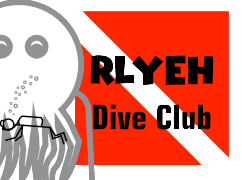Blood and Plunder is a tabletop miniatures game from Firelock Games that aims to provide an experience of historical large-scale skirmish fighting in the 17th and 18th century. Key features of the game include a lot of historical detail, support for ships and fortifications, and a wide range of playable nations each with more specific factions.
The Most important point of this review is I haven’t played the game. I was interested and picked up the PDF from Firelock Games’ store. I had some definite concerns after skimming this book, but picked up the Raise the Black book to sample the expansions and give the game a fighting chance.
I don’t think this is the game for me, but I don’t think that makes it a bad game. I did find it interesting enough I ordered the more traditional skirmish spin-off Port Royal , which ships in a few months.
Reviewing the Reviewer #
I’m already admitting that I’m reviewing a game I haven’t played. Another caveat is I’ve never been big into historical games, preferring mecha and/or wizards in my content. I do like to check out other games. For example, I’ve read some of the Flames of War rulebooks (I like their strategy of doing Theatre-specific expansions) but never played. One reason I look t games is to look at how they solve recurring issues like handling constructing a force for the game.
The Game Line #
I feel a good way to look at a game is to step back and consider how the game is packaged and sold. There’s no wrong answers, but a game sold as a complete package is going to be very different from the traditional tabletop miniatures game model that expects selective buying and expansions.
Blood and Plunder has a 2 player starter set that looks like a great way to get into the game. It’s currently $99 dollars and includes an undeniably satisfying amount of “stuff” including:
- Softcover Rulebook (the PDF I am reviewing is the same as this book to my understanding )
- Commander minis for Edward “Blackbeard” Teach and Robert Maynard
- 24 Sailor models
- 2 Sloop kits (a solid “real ship” for the system)
- 2 activation decks (playing cards, but modified)
- Play mat
- Various markers and templates
- Dice
- Ruler
The two sloops alone list for $39 apiece from Firelock’s online store, so I’d consider this set a good value if this game interests you. The included troop models are a bit limited , but they’re also generic sailors that can be used with most factions to my understanding.
They also sell various bundles that are faction specific. They are trying to provide troops in plastic whenever possible with less common units and characters in either pewter or resin.
The paradigm seems to be a core book that covers the entire game but focuses mostly on the 17th century followed by expansions that narrow this focus to specific time periods. I was curious about a few aspects of the game so ended up picking up the Raise the Black ebook, which I will cover in more detail below. At this time there’s only a few books in the line:
- Blood & Plunder Core Rulebook Revised Edition (the main rules; I picked this up t9 gauge my interest in the game.
- Raise the Black (18th century heavy on pirates; I picked this up to see how the game was being expanded.)
- Fire on the Frontier (conflicts with Native Americans: Expanded fortifications; I have seen minimal references to this book amongst the B&P community suggesting it may not be the most popular.)
- No Peace Beyond the Line (I initially skipped this as it’s described as “supplement to the original Blood & Plunder rule book” but it seems like it is a de facto secondary main rulebook.
Overall like that they’re focusing on era or regions instead of trying to do the factions specific books that was the old “standard” for many game lines. This is a good thing: It provides value for gamers, and you don’t feel like you need to buy the Blue Square Faction book because despite playing the Green Triangles you know you’ll need to know the Blue Faction special rules. (I’d also argue that from a sales standpoint, if I buy a book for a game and it has rules for a faction I’m not interested in, there’s a chance I’d see fun models and such that make me interested in that faction.)
The downside is this core book really feels like a quick start guide that grew too big to be a free pack-in or download. At the same time it’s not comprehensive: It looks like No Peace Beyond the Line is a de facto “advanced rule book” that greatly expands the game.
Exploring the Core Rulebook #
So for those starting with the starter, you get the Blood and Plunder Core Rulebook Revised Edition which is a healthy 174 page PDF.
Overview #
This is a pretty book: An opening spread is a map of the Spanish Main. The book uses large, full-color art of brightly painted miniatures as chapter breaks and inspirational art. There’s diagrams for critical rules and a few pieces of quality line art I found evocative. My biggest complain with the design is in a few places the page background effects actually made a word hard to read.
The full color photos do something I approve of: They appear to be ‘game ready’ minis as opposed to the modified minis many game lines use. They’re shown with full bases and in realistic looking groupings.
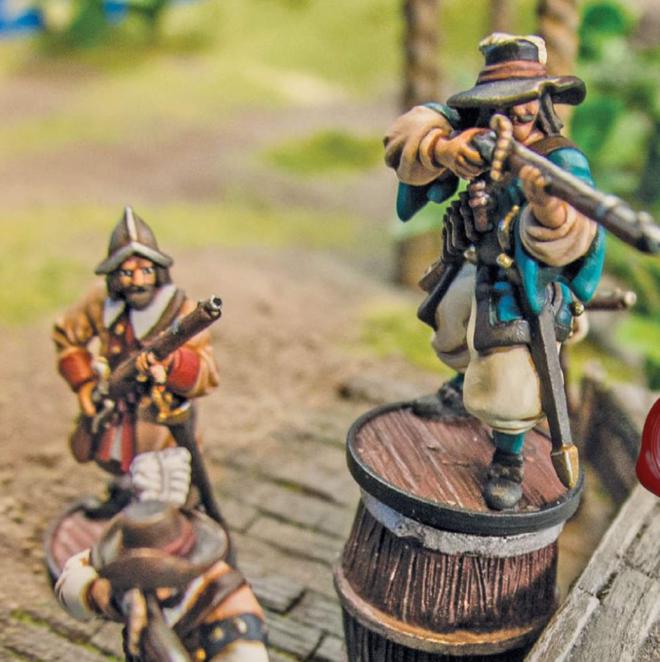
Historical Accuracy #
Firelock Games is very proud of their historical accuracy for the game and miniature. This is why I was not surprised that the book starts with 17 pages of background. It’s presented as a timeline and I do think it lacks some useful clarification. For example, the period covered centers heavily on buccaneers but I didn’t come away with a good grasp of the difference between buccaneers and pirates. Admittedly, the terms are very fluid.
The game is truly a historical game focusing on the various nations and independent groups that would be active in the New World in the specified time period. This is a game with no real heroes: Don’t expect Jack Sparrow fighting skeletal pirates out of the Pirates of the Caribbean movies. It’s not even a “Herohammer” style game of Errol Flynn where the Commanders and other characters engage in duels or use special abilities. The Commander and character rules, while essential, are more about commanders enhancing the units they are attached to.This is a game of troops assaulting for loot, survival, or revenge.
The rules appear to be mostly well-written. I can only comment so far on the content of the rules as I haven’t played them, but they seem relatively clear and logical. I did notice a few oddities, like several Special Rules that reference an ‘Army Scale’ variant not described here. I’ll discuss those oddities more alter.
There’s an interesting discussion in rules design forums about writing rules to teach the game vs writing as a rules reference and both have value. I feel most miniatures rules favor the latter as there’s such a need for various special case rules. Blood and Plunder handles this by a few box-texts where the rules encouragingly suggest the reader actually play a game to use the mechanics learned so far. For example, page 60 recommends a starter game using the basic land rules to learn the basics before adding in Structures and Artillery, Page 78 has a similar suggestion to add in Structures (specifically a building on land as opposed to a ship) and Artillery. After this I don’t think there’s another, but you should be ready to play the full game. It’s a fun approach I feel, and enhances the idea by specifically suggesting that the learning games might be a quick proxy skirmish suing available miniatures if you don’t have their special minis assembled and painted yet.
Mechanics #
The game is based around d10 dice used with clean basic mechanics: Models have simple values for ranged and melee attacks and individual saves for the same. If a model has a 5 to shoot, they succeed on a 5 or greater on a single die. Weapons, equipment, and special rules will modify this with everything from modifiers to adding limited exploding dice: Some models may gain the ability to roll an extra d10 on a roll of 10. Models have an Experience level which in play mostly seems to give them more activations if they’re experienced.
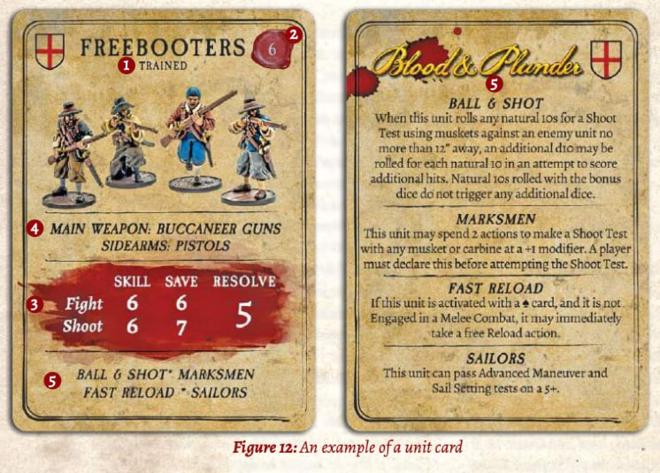
Injury and Fatigue #
In general, any attack that hits causes a model to be removed if there’s no successful save. However, Fatigue is a major mechanic. A model rolls a single die every time it’s attacked, and an additional die for each casualty taken. This is against the unit’s Resolve statistic with each failure meaning the unit takes a point of Fatigue. Units can also take a Fatigue point voluntarily for a small boost in some situations.
Accumulated Fatigue has increasingly worse effects. Losing actions in the future is one effect, but at a point the unit becomes Shaken or even Rout. Shaken units must use the Rally action to recover, while Routed units are removed from play.
Activation #
Each player has a deck of cards (A normal deck can be sued, but the decks from the manufacturer can make some uses easier) and draws a number of cards each turn equal to the number of units they’re fielding. A unit is a clump of troops, which may have a Commander added to the unit, or may replace orupgrade some members with specialists. Jokers drawn trigger random events which are resolved instantly, then replaced. The cards are played face-down and determine initiative based on the suite with the card value as a tiebreaker. The high card then picks a unit to activate which gains a number of actions based on the card: Essentially, if you play a Club you will likely lose initiative, but your more experienced unit gains three actions. On the other hand a Spade likely goes first, but grants less actions.
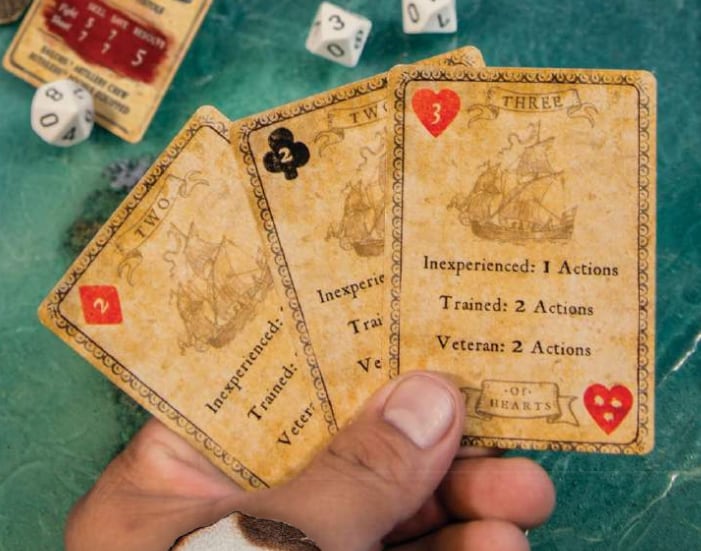
Essentially this creates an interesting sort of ‘bidding’ setup where players are trying to decide between moving first (by playing a Spade or Heart) or maximizing actions (by playing a card from the clubs or diamonds).
Units have a wide range of Action options and may gain “Free Actions” at times. Actions are used to move the unit (There’s a standard 4” speed), shoot, etc. Some actions are Dedicated Actions such as Dismounting from horses or Changing Sail Settings if on a ship. These essentially are ‘full round’ and must be done first, consuming all viable actions. (A nice twist is if you give a unit a card that grants it three actions, it gets a bonus when using a dedicated action for the actions it can’t use.) Assignment Actions are similarly restricted, but represent taking up roles as artillery or ship’s crew.
Certain Special Rules trigger when a unit is activated by a specific suite which may contribute to a player’s decision making process as well.
Structures and Ships #
Ships, along with shore defenses and artillery, are a major part of the rules. They get about a dozen pages of rules, but build on earlier rules for structures. There’s some near ideas in these rule.
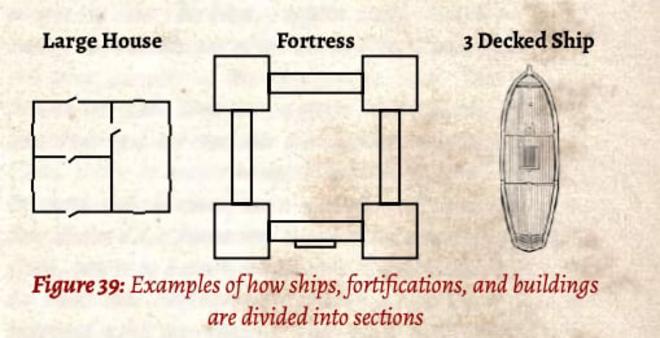
Buildings #
A clever part of the structure rules is treating a structure as a set of roughly 4” square regions called sections. On the ships these represent the various decks. This is done to make moving models easier I assume. The range to an adjacent section is always 4” and players can move minis without the need to measure or micromanage positioning. Theres a limit of two friendly units per section. Sections, especially on Ships, aren’t always the same size and the unit of 20mm-based models must fit itself into the ship.
Structures are tough, requiring artillery, explosives to remove them from play. They have a Critical hit table, with a more specific table for Ships.
Ships #
The ships are definitely a ‘star’ of this game. Many of the full-color images in the rules feature them, and the 2 player starter comes with two small ships. The included rulebook includes four classes of ships which are summarized below in order of Size or Decks:
- Longboat: a single deck ship that doesn’t have much going for it other than being cheap. It can mount a single swivel gun (a very light cannon mounted on a mount that can be aimed and fired quickly). This is considered a ‘Boat’ by the rules which brings in some special rules due to being much lighter and smaller.
- Sloop: a 2 deck ship that is a good example of a “real” ship and, coincidentally, the ship that the 2 player Starter Set includes.
- Brigantine: At 3 decks, the Brigantine is the largest ship in the list with the Sweeps rule, which represent the ship being able to use oars if the wind is unfavorable. It can also mount more swivel guns than the larger Light Frigate, but less cannons.
- Light Frigate: The largest ship in this book is four decks and can carry over a dozen cannons.
As far as point costs the Light Frigate is 21 points in a game that recommends game sizes of 100 to 400. The humble longboat is only 3 points: Some art for the game (and a special rule allowing Units to stretch across the smallest ships) suggests running multiple small vessels if your plan is rushing and boarding other ships.
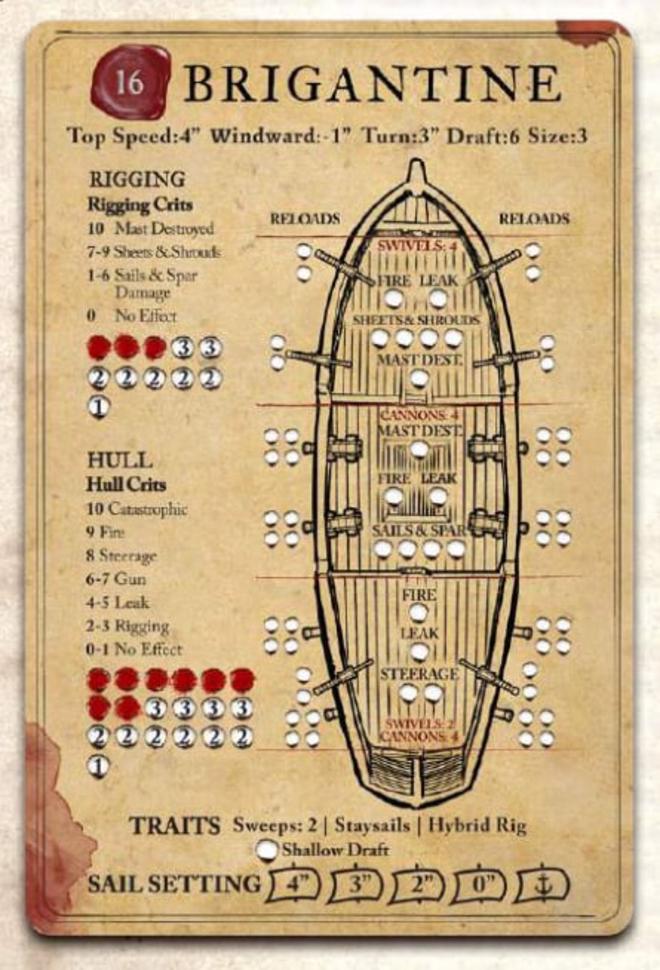
In general Ships are structures that move: There’s rules for handling the sailing aspect. The ‘sections are 4 inch squares’ is relevant here as the movement to go between decks is always 4”, as is range.
The ship rules feel like a focus of the game and there’s a lot of thought in them. There’s even rules for executing a “scroll” if a ship leaves the table in which all terrain is moved down or off the table assuming it won’t break the game. The developers clearly spent time on making ship to ship combat fun.
In general ships are a ‘generic’ resource available to every faction. The later books introduce Native American factions which are generally limited to the smaller ships, but that seems like an exception to the nature of the rules.
The ship rules interact with regular units by using the Assignment actions mentioned earlier. Everyone can crew a ship, but those with the Sailors special rule gain a bonus. Firelock Games sells a ‘sailors’ box and most faction lists have one or two lightly-armed troops that have the Sailors special rule.
Force Construction and Available Options #
Firelock Games has a Force Builder web app , to aid construction. It’s relatively simplistic to buiild a force in that a force has a single Commander and appropriate faction which grants a list of Core Units (you can take as many units of these as you wish) and Support Units (which are limited to one per two Core Units). These can be enhanced with additional characters and equipment then, of course, loaded in cannon-laden ships.
Around this point I do feel like the core book has some issues with organization and content: After the overview there’s a subsection on Commanders followed by a separate Subsection detailing each faction and the troops included. It’s awkward and later books simplified the layout a bit.
An interesting bit is by the rules, Step 5 of the Force creation rules is selecting a scenario, which is then followed by selecting and outfitting ships and fortifications. There’s no purchasable fortifications in this book that I can find (unless field guns are included) so in actual I’d assume some back and forth for players to generate a force as units would need to be expanded or added if no ships are taken. Alternatively (and choosing a scenario is explicitly supported) I’d assume that a player who just got a new ship painted is going to want to use their new ship!
The Scenario section has it’s own separate 6 step process. Players should choose to play a land battle, amphibious battle, or sea battle based on their interest and if they have the necessary components.
Commanders #
This book divides commanders into three classes (Standard, Historic, and Legendary) and provides several examples of each. There’s more commanders than troop types per faction, in fact!
The rules for Commanders in play is that they are attached to a unit and essentially share special rules with them. Your Commander might give a unit a rule to represent the leader’s special training, or might effectively block stealth options via the High Standing rule. They even use their host unit’s combat statistics, although they have their own weapons and gear. They have a Command Range used for their abilities such as spending COmmand Points which cary by commander.
Standard Commanders #
Standard commanders cover the bottom of the range with the cheapest of them being free. These are generic, unnamed commanders who come in faction-specific varieties (The Spanish get a set of commanders for the Spanish Militia and a second set for the Guarda Costa) and three grades (Untested, Experienced, and Seasoned). They look like solid choice but generally lacking in the more exciting Special Rules.
Historic Commanders #
These are named characters modeled after real-world people. They have a mix of rules, often adding Special Rules. Some of their rules are unique rules such as Robert Searle’s Aggressive Commander rule which grants a special rule to everyone within command range.
Legendary Commanders #
Each faction has a single Legendary Commander as of this book with the exception of the Bretheren of the Coast which we’ll discuss briefly later. These characters get a much larger write-up than the Historical commanders and more dramatic rules. They have much larger Command Ranges and Special Rules. Note that the Starter includes Edward “Blackbeard” Teach and Robert Maynard, neither of which are described here (but the starter may include cards for them).
Factions and Units #
Each Nation includes two factions and four Units. The three factions in this book are the Spanish, English, and French. The four unit options seem a bit limiting, but some Factions do take units from other Nations.
I also feel like the units presented don’t feel diverse enough. There’s a narrow range of statistics with most around 5-7 and occasional outliers. Special Rules and weapon rules should help differentiate them, but there’s so many rules I don’t feel they’re easily internalized.
Factions may add in upgrade options for troops. Some troops also have built-in weapon and equipment options, Also there’s a few options buried in the later equipment section (like torches) that are easily missed.
Characters #
The Character section outlines an interesting system to add specialists to enhance a unit. The rules are kind of a mess though, with several concerns. First, there’s several constraints on characters, but at the same time the rules mention that specific characters may break these rules. Some (Fighting Men) are a sort of “upgrade” in which you pay points to swap a standard character of a unit for an upgrade. On the other hand the “Advisors & Hostages” add an additional unit. I think it’s done as the former has a combat role while the latter is a more secondary role, but it feels messy.
More frustrating, of these two classes of characters we get one example. Not even one each, but one total! The only character present in this book is the Spiritual Leader, essentially a way to add a special Fortune Point to a force that. The Fighting Men have no examples despite the rules suggesting they should be on a Table.
The expansion books develop this aspect of the game with multiple options.
Ships and Structures #
As Is aid I feel the book got a bit disorganized as the rules proceeded, and this continues with adding a ship to a force. There’s a clear table of the 4 ships described here in section 9.5 on page 199, but you’ll need to skip to page 155, section 14.3, for the Artillery Rules Quick Reference to find the point values for cannon and related items. The closest thing to pricing for structures is taking cannon on a structure or field carriages.
Bretheren of the Coast #
Want to play pirates? If you’re interested in this game it’s at least likely someone does. As of this book the only ‘pirate’ option is meant to be a sort of multi-national force with a goal of taking what they can from the Spanish forces in the region. This is the only faction under the book’s “Unaligned Factions” banner. In lieu of fielding their own Commanders or troops the Brethren use a selection from other faction’s lists.
Special Rules and Weapons #
There’s several sections of special rules: Ship Traits, Weapons, and Equipment being de facto Special Rules in addition to the Special Rules in usage. Some rules are negative rules, which I’ve learned are the most likely to be forgotten even by players focused on good sportsmanship. For example, the Heavy Melee Weapons basically impose a +1 Penalty to both the wielder’s Melee Saves as well as opponents.
Mercifully there’s one page of Ship Traits and you’ll hopefully only need to know a few at a time. Some are somewhat ‘advanced’ as they require some experience with the rules for managing sails. A few rules are skipped and we’re directed to the No Peace Beyond the Line book for the Fighting Platform, Fighting Tops, Poop Deck, Gallery, and Gun Decks Traits.
Special Rules cover 5 pages and are something a player likely needs to internalize. Luckily you may only need 2-3 units worth of rules, but keep in mind these are in addition to the unique Faction rules which often grant these rules. Three pages of Weapons feel intimidating. I assume in small learning games you’re only going to see 2-3 examples of ranged and melee weapons.
Scenarios and Miscellaneous #
After a few pages detailing Fortune Points (Essentially re-rolls that are in addition the Command Points and allow re-rolls or a last-second save for a Commander to help prevent a game being very short or boring due to early game bad rolls) and Events (Jokers drawn trigger events which cause various fun things including changing the weather and wind conditions) the book has a healthy section on scenarios. Morale is effectively hidden in this section under the section header of “13.2 Strike Points and Strike Tests” which details a basic morale system based on accruing points based on various triggers like taking casualties, losing ships, or seeing the enemy fulfill mission requirements. An interesting twist is a Strike Test (which may cause a force to surrender the game) is triggered when a force has at least two more strike points than the opponent: If both forces are grinding away at each other equally they may not trigger these rolls.
Verdict #
I’ve decided to personally pass on Blood & Plunder. It’s a tiny bit larger scale than I like: It’s smaller in model count than current Warhammer 40k rules, but as of this book normal troops range from 3-7 points for base prices so it’s quite possible to need a few dozen for a 200 point game. The ships look fun, with the larger game allowing a daring raid in longboats up to assaulting an outpost from a frigate armed with several cannons.
I think the company has put a lot of effort into the game. I’ve pre-ordered Port Royal which looks to be a bit more my speed. I’m expecting much smaller forces with a bit more detail and hoping to see the same creativity with more character customization.

If Firelock Games asked I would recommend cleaning up the rules a bit. If the Core Rulebook could be a single, ideally freely downloadable, document that was the current rules minus the background and such I feel it would benefit the game. The No Peace Beyond the Line book appears to be necessary for some aspects of larger ships and such. Providing a simpler, better organized book would be a better value and more interesting for new players. A few aspects, like the Army Scale rules I mentioned earlier, might be left out. I’m personally much more interested in being able to add the larger ships than playing a game with multiple forces per side.
I do hope to write some similar (perhaps shorter) articles for the Raise the Black and No Peace Beyond the Line books over the next month or two.
